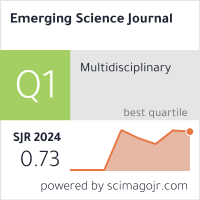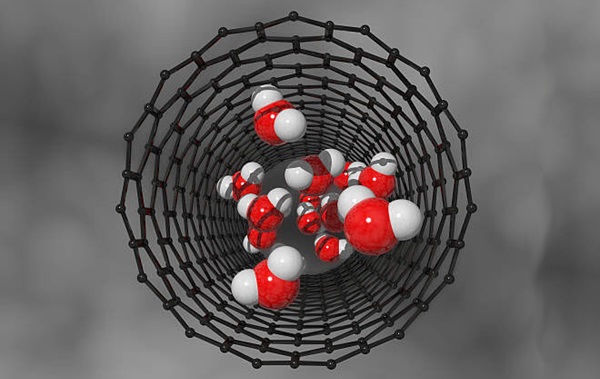Students Proactive Decision-Making Scale (SPDMS-18)
Downloads
This study uses the analysis, development, implementation, and evaluation research design to innovate the student proactive decision-making scale. Considering the needs analysis, the researcher constructed 18 items validated by five raters and tested on 849 students from various universities in Indonesia. The content validity test used Aiken’s formula, and the inter-rater reliability test used Pearson’s ICC. While the construct validity and reliability test used CB-SEM analysis, and the concurrent validity test used Spearman’s correlation between SPDMS-18 and Melbourne DMQ. The results of content validity proved that 18 items met Aiken’s parameters (0.80-1.00), Pearson’s ICC value = 0.524, and Cronbach alpha value = 0.846. Construct validity testing proves that the SPDMS-18 loading factor values range from 0.709-0.835, Cronbach alpha values range from 0.752-0.835, composite reliability values range from 0.751-0.839, AVE values range from 0.502-0.634, and discriminant validity values range from 0.709-0.797. The GoF test model proves that the Chi-Square/df value = 3.002, RMSEA value = 0.049, SRMR value = 0.027, NFI value = 0.958, TLI value = 0.963, and CFI value = 0.971. The concurrent validity results using Spearman’s correlation confirmed the sig. value = <0.001. Thus, SPDMS-18 has a significant psychometric function with the actual situation. It becomes one of the references lecturers can use to measure, assess, and evaluate students’ proactive decision-making in lectures.
Downloads
[1] Knox Clarke, P., & Campbell, L. (2020). Decision-making at the sharp end: A survey of literature related to decision-making in humanitarian contexts. Journal of International Humanitarian Action, 5(1), 2. doi:10.1186/s41018-020-00068-2.
[2] Andreis, F. de. (2020). A theoretical approach to the effective decision-making process. Open Journal of Applied Sciences, 10(6), 287–304. doi:10.4236/ojapps.2020.106022.
[3] Carbone, E., Georgalos, K., & Infante, G. (2019). Individual vs. group decision-making: An experiment on dynamic choice under risk and ambiguity. Theory and Decision, 87(1), 87–122. doi:10.1007/s11238-019-09694-8.
[4] Adal, E. E., & Cakiroglu, J. (2023). Investigation of preservice science teachers’ nature of science understanding and decision making on socioscientific issue through the fractal model. Science and Education, 32(2), 529–565. doi:10.1007/s11191-022-00319-1.
[5] Samsuri, W., Sumarta, S., & Acep Bahrum, A. B. (2023). Exploring teachers’ practical decision making in terms of teaching procedures. Academy of Education Journal, 14(1), 40–48. doi:10.47200/aoej.v14i1.1356.
[6] Siebert, J., & Kunz, R. (2016). Developing and validating the multidimensional proactive decision-making scale. European Journal of Operational Research, 249(3), 864–877. doi:10.1016/j.ejor.2015.06.066.
[7] Negulescu, O., & Doval, E. (2014). The quality of decision making process related to organizations’ effectiveness. Procedia Economics and Finance, 15, 858–863. doi:10.1016/s2212-5671(14)00548-6.
[8] Savioni, L., Triberti, S., Durosini, I., & Pravettoni, G. (2023). How to make big decisions: A cross-sectional study on the decision-making process in life choices. Current Psychology, 42(18), 15223–15236. doi:10.1007/s12144-022-02792-x.
[9] Oni, A. A., & Adetoro, J. A. (2015). The effectiveness of student involvement in decision making and university leadership: A comparative analysis of 12 universities in South-west Nigeria. Journal of Student Affairs in Africa, 3(1), 65–81. doi:10.14426/jsaa.v3i1.93.
[10] Garrecht, C., Bruckermann, T., & Harms, U. (2018). Students’ decision-making in education for sustainability-related extracurricular activities-a systematic review of empirical studies. Sustainability (Switzerland), 10(11), 3876. doi:10.3390/su10113876.
[11] Zeidler, D. L., Sadler, T. D., Simmons, M. L., & Howes, E. V. (2005). Beyond STS: A research-based framework for socioscientific issues education. Science Education, 89(3), 357–377. doi:10.1002/sce.20048.
[12] Kumschick, I. R., Thiel, F., Goschin, C., & Froehlich, E. (2020). Decision-making in teaching processes and the role of mood: A study with preservice teachers in Germany. International Journal of Emotional Education, 12(2), 56–72.
[13] Mati, A., Gatumu, J. C., & Chandi, J. R. (2016). Students’ involvement in decision making and their academic performance in Embu West Sub-County of Kenya. Universal Journal of Educational Research, 4(10), 2294–2298. doi:10.13189/ujer.2016.041008.
[14] Sakamoto, M., Yamaguchi, E., Yamamoto, T., & Wakabayashi, K. (2021). An intervention study on students’ decision-making towards consensus building on socio-scientific issues. International Journal of Science Education, 43(12), 1965–1983. doi:10.1080/09500693.2021.1947541.
[15] Abdullah, M. S., & Rahman, S. (2020). The relationship between decision making skills and students’ behaviour management. International Journal of Academic Research in Business and Social Sciences, 10(14), 246–257, doi:10.6007/ijarbss/v10-i14/7693.
[16] Torlak, N. G., Demir, A., & Budur, T. (2022). Decision-making, leadership and performance links in private education institutes. Rajagiri Management Journal, 16(1), 63–85. doi:10.1108/ramj-10-2020-0061.
[17] Yuniarti, W. D., Hartati, S., Priyanta, S., & Surjono, H. D. (2024). Learner assessment system in e-learning with OBE Approach: Activity performance, ability level and recommendation. HighTech and Innovation Journal, 5(3), 572–602. doi:10.28991/HIJ-2024-05-03-03.
[18] Hassan Majeed, B. (2021). The skill of making a decision and its relationship of academic achievement among students. International Journal of Recent Contributions from Engineering, Science & IT (IJES), 9(4), 77–89. doi:10.3991/ijes.v9i4.26363.
[19] Prenger, R., & Schildkamp, K. (2018). Data-based decision making for teacher and student learning: A psychological perspective on the role of the teacher. Educational Psychology, 38(6), 734–752. doi:10.1080/01443410.2018.1426834.
[20] Hershauer, J. C., & Simon, H. A. (1978). The new science of management decision. The Academy of Management Review, Prentice Hall, Pearson Education, New Jersey, United States. doi:10.2307/257591.
[21] Carroll, J. S., & Johnson, E. J. (1990). Decision research: A field guide (1st ed.). SAGE Publications, Inc. New Jersey, United States.
[22] Al Shra’ah, A. E. M. (2015). The impact of decision making styles on organizational learning: An empirical study on the public manufacturing companies in Jordan. International Journal of Business and Social Science, 6(4), 54–62.
[23] Fattah, J., Yesiltas, M., & Atan, T. (2022). The impact of knowledge sharing and participative decision-making on employee turnover intention: The mediating role of perceived organizational support. SAGE Open, 12(4), 215824402211302. doi:10.1177/21582440221130294.
[24] Valverde-Moreno, M., Torres-Jiménez, M., Lucia-Casademunt, A. M., & Pacheco-Martínez, A. M. (2021). Do national values of culture and sustainability influence direct employee pdm levels and scope? The search for a european answer. Sustainability (Switzerland), 13(14), 8016. doi:10.3390/su13148016.
[25] Lam, S. S. K., Chen, X. P., & Schaubroeck, J. (2002). Participative decision making and employee performance in different cultures: The moderating effects of allocentrism/idiocentrism and efficacy. Academy of Management Journal, 45(5), 905–914. doi:10.2307/3069321.
[26] Siebert, J. U., Kunz, R. E., & Rolf, P. (2020). Effects of proactive decision making on life satisfaction. European Journal of Operational Research, 280(3), 1171–1187. doi:10.1016/j.ejor.2019.08.011.
[27] Hernández-Navarro, L., Hermoso-Mendizabal, A., Duque, D., de la Rocha, J., & Hyafil, A. (2021). Proactive and reactive accumulation-to-bound processes compete during perceptual decisions. Nature Communications, 12(1), 7148. doi:10.1038/s41467-021-27302-8.
[28] Bateman, T. S., & Crant, J. M. (1993). The proactive component of organizational behavior: A measure and correlates. Journal of Organizational Behavior, 14(2), 103–118. doi:10.1002/job.4030140202.
[29] Greenglass, E., Schwarzer, R., & Taubert, S. (2008). The proactive coping inventory (PCI): A multidimensional research instrument the 7 subscales of the proactive coping inventory: 20th International Conference of the Stress and Anxiety Research Society, 7–9.
[30] Shek, D. T. L., & Chai, W. Y. (2019). Psychometric properties of the service leadership attitude scale in Hong Kong. Frontiers in Psychology, 10(May), 805–815. doi:10.3389/fpsyg.2019.01070.
[31] Trifiletti, E., Capozza, D., Pasin, A., & Falvo, R. (2009). A validation of the proactive personality scale. TPM - Testing, Psychometrics, Methodology in Applied Psychology, 16(2), 77–93.
[32] Bekhter, A. A., & Filatova, O. A. (2022). Adaptation of R. Schwarzer’s proactive attitudes scale: Validation and psychometric testing on a sample of Russian youth. RUDN Journal of Psychology and Pedagogics, 19(1), 158–178. doi:10.22363/2313-1683-2022-19-1-158-178.
[33] Teye-Kwadjo, E., & de Bruin, G. P. (2022). Rasch analysis of the proactive personality scale. Psychological Reports, 125(5), 2788–2806. doi:10.1177/00332941211028110.
[34] Branch, R. M. (2010). Instructional design: The ADDIE approach. Springer, Berlin, Germany. doi:10.1007/978-0-387-09506-6.
[35] Mann, L., Burnett, P., Radford, M., & Ford, S. (1997). The Melbourne decision making questionnaire: An instrument for measuring patterns for coping with decisional conflict. Journal of Behavioral Decision Making, 10(1), 1–19. doi:10.1002/(SICI)1099-0771(199703)10:1<1::AID-BDM242>3.0.CO;2-X.
[36] Scott, S. G., & Bruce, R. A. (1995). Decision-making style: The development and assessment of a new measure. Educational and Psychological Measurement, 55(5), 818–831. doi:10.1177/0013164495055005017.
[37] Aiken, L. R. (1985). Three coefficients for analyzing the reliability and validity of ratings. Educational and Psychological Measurement, 45(1), 131–142. doi:10.1177/0013164485451012.
[38] Koo, T. K., & Li, M. Y. (2016). A guideline of selecting and reporting intraclass correlation coefficients for reliability research. Journal of Chiropractic Medicine, 15(2), 155–163. doi:10.1016/j.jcm.2016.02.012.
[39] Scholtz, S. E. (2021). Sacrifice is a step beyond convenience: A review of convenience sampling in psychological research in Africa. SA Journal of Industrial Psychology, 47, 1837. doi:10.4102/sajip.v47i0.1837.
[40] Mahardika, I. M. S., Blegur, J., Berliana, Anaktototy, J., Boleng, L. M., & Arhesa, S. (2024). Global transformational leadership scale: cross-cultural adaptation of Indonesian sports science student context. International Journal of Evaluation and Research in Education, 13(5), 3068–3080. doi:10.11591/ijere.v13i5.29122.
[41] Hair Jr, J., Page, M., & Brunsveld, N. (2019). Essentials of business research methods. Routledge, New York, United States.
[42] Hair Jr, J. F., Black, W. C., Babin, B. J., Anderson, R. E., Black, W. C., & Anderson, R. E. (2019). Multivariate data analysis. Cengage Learning, London, United Kingdom.
[43] Hulland, J. (1999). Use of partial least squares (PLS) in strategic management research: A review of four recent studies. Strategic Management Journal, 20(2), 195–204. doi:10.1002/(sici)1097-0266(199902)20:2<195::aid-smj13>3.0.co;2-7.
[44] Kay Kwong, K. W. (2013). Partial least square structural equation modeling (PLS-SEM) techniques using SmartPLS. Marketing Bulletin, 24(1), 1–32.
[45] Henseler, J., Hubona, G., & Ray, P. A. (2016). Using PLS path modeling in new technology research: Updated guidelines. Industrial Management and Data Systems, 116(1), 2–20. doi:10.1108/IMDS-09-2015-0382.
[46] Fornell, C., & Larcker, D. F. (1981). Evaluating structural equation models with unobservable variables and measurement error. Journal of Marketing Research, 18(1), 39–50. doi:10.1177/002224378101800104.
[47] Akinyode, B. F. (2016). The use of structural equation modeling (SEM) in built environment disciplines. International Institute for Science, Technology and Education (IISTE), 6(6), 2225–0484. www.iiste.org
[48] Dash, G., & Paul, J. (2021). CB-SEM vs PLS-SEM methods for research in social sciences and technology forecasting. Technological Forecasting and Social Change, 173, 121092. doi:10.1016/j.techfore.2021.121092.
[49] Hair, J. F., Hult, G. T. M., Ringle, C. M., Sarstedt, M., Danks, N. P., & Ray, S. (2021). An introduction to structural equation modeling. Partial least squares structural equation modeling (PLS-SEM) using R: A workbook. Springer, Cham, Switzerland. doi:10.1007/978-3-030-80519-7_1.
[50] Henseler, J., & Schuberth, F. (2024). Should PLS become factor-based or should CB-SEM become composite-based? Both! European Journal of Information Systems, 34(3), 551–563. doi:10.1080/0960085X.2024.2357123.
[51] Hosmer, D. W., & Lemeshow, S. (1980). Goodness of fit tests for the multiple logistic regression model. Communications in Statistics - Theory and Methods, 9(10), 1043–1069. doi:10.1080/03610928008827941.
[52] Ryu, E. (2014). Model fit evaluation in multilevel structural equation models. Frontiers in Psychology, 5(Feb), 1–9. doi:10.3389/fpsyg.2014.00081.
[53] Adams, H., Cervantes, P., Jang, J., & Dixon, D. (2014). Standardized assessment. In D. Granpeesheh, J. Tarbox, A. C. Najdowski, & J. Kornack (Eds.), Evidence-Based Treatment for Children with Autism: The CARD Model (1st ed.). Academic Press, 501–516. doi:10.1016/B978-0-12-411603-0.00025-2.
[54] Lin, WL., & Yao, G. (2014). Concurrent validity. In: Michalos, A.C. (eds) Encyclopedia of Quality of Life and Well-Being Research. Springer, Dordrecht, Germany. doi:10.1007/978-94-007-0753-5_516
[55] Lee, H. Suk, Ko, M., & Kim, H. J. (2023). Concurrent validity of dual-task walking speed with cerad-np assessment battery in community-dwelling older adults. Archives of Rehabilitation Research and Clinical Translation, 5(4), 100291. doi:10.1016/j.arrct.2023.100291.
[56] Song, J., Howe, E., Oltmanns, J. R., & Fisher, A. J. (2023). Examining the concurrent and predictive validity of single items in ecological momentary assessments. Assessment, 30(5), 1662–1671. doi:10.1177/10731911221113563.
[57] Sanders, O., Wang, B., & Kontson, K. (2024). Concurrent validity evidence for pressure-sensing walkways measuring spatiotemporal features of gait: A systematic review and meta-analysis. Sensors, 24(14), 4537. doi:10.3390/s24144537.
[58] Schober, P., & Schwarte, L. A. (2018). Correlation coefficients: Appropriate use and interpretation. Anesthesia and Analgesia, 126(5), 1763–1768. doi:10.1213/ANE.0000000000002864.
[59] Dancey, C. P., & Reidy, J. (2007). Statistics without maths for psychology. Prentice Hall, Pearson Education, New Jersey, United States.
[60] Cronin, L. D., & Allen, J. (2017). Development and initial validation of the life skills scale for sport. Psychology of Sport and Exercise, 28, 105–119. doi:10.1016/j.psychsport.2016.11.001.
[61] Jaworski, M., Panczyk, M., Cieślak, I., Baranowska, A., Brukało, K., Grzebieluch, J., Kwaśniewska, M., Urbaniak, M., Zarzeczna-Baran, M., Zyska, A., & Gotlib, J. (2022). The role of life skills in developing an authentic leadership attitude in public health students: A multicenter cross-sectional study in Poland. BMC Public Health, 22(1), 1485. doi:10.1186/s12889-022-13907-1.
[62] Hoskins, B., & Liu, L. (2019). Measuring life skills in the context of life skills and citizenship education in the Middle East and North Africa. United Nations Children’s Fund (UNICEF) and International Bank for Reconstruction and Development. The World Bank, Washington, D.C., United States.
[63] Al-Yousifi, A. A., & Murad, Y. A. K. (2022). Proactive decisions and their relationship to the emotions of academic achievement among university students. International Journal of Health Sciences, 6(4), 11980–11990. doi:10.53730/ijhs.v6ns4.11678.
[64] Tanau, F. O., & Salim, R. M. A. (2020). Proactive personality and career decision self-efficacy: The mediating role of planned happenstance. HUMANITAS: Indonesian Psychological Journal, 17(2), 123–131. doi:10.26555/humanitas.v17i2.13775.
[65] Darmayanti, K. K. H., & Salim, R. M. A. (2020). The enhanced career decision-making self-efficacy by emotional intelligence depended on proactive personality. Electronic Journal of Research in Educational Psychology, 18(50), 121–142. doi:10.25115/EJREP.V18I50.2685.
[66] Siebert, J. U., Becker, M., & Oeser, N. (2023). Making a good career choice: A decision-analytical intervention to enhance proactive decision-making and career choice self-efficacy in high school students. Decision Sciences Journal of Innovative Education, 21(1), 10–25. doi:10.1111/dsji.12280.
[67] Siebert, J. U., Kunz, R. E., & Rolf, P. (2021). Effects of decision training on individuals’ decision-making proactivity. European Journal of Operational Research, 294(1), 264–282. doi:10.1016/j.ejor.2021.01.010.
[68] Zhou, H., Hou, J., Yang, L., Tu, Y., Liu, Y., & Hu, R. (2021). Analysis of the status of career decision-making and its influencing factors among nursing postgraduate students. Chinese Journal of Practical Nursing, 37(11), 831–837. doi:10.3760/cma.j.cn211501-20200710-03104.
[69] Melović, B., Šekularac-Ivošević, S., Muslu, A., Backović, T., & Dabić, M. (2022). Proactive career planning in the maritime industry: Enhancing millennials’ workplace enthusiasm in Montenegro and Turkey. Nase More, 69(1), 40–52. doi:10.17818/NM/2022/1.6.
[70] Hou, C., Wu, L., & Liu, Z. (2014). Effect of proactive personality and decision-making self-efficacy on career adaptability among Chinese graduates. Social Behavior and Personality: An International Journal, 42(6), 903–912. doi:10.2224/sbp.2014.42.6.903.
[71] Blegur, J., Wasak, M. R. P., & Souisa, M. (2019). The correlation between time management and student learning outcomes in physical education. Facta Universitatis, Series: Physical Education and Sport, 17(2), 289–298. doi:10.22190/fupes190702027b.
[72] Blegur, J., Haq, A. H. B., & Barida, M. (2021). Exploring goal–setting strategies of prospective physical education teachers to maintain academic performance. AL-ISHLAH: Jurnal Pendidikan, 13(1), 473–484. doi:10.35445/alishlah.v13i1.539.
[73] Torkashvand, M., Pourrahimi, M., Jalilvand, H., Abdi, M., Nasiri, E., & Haghi, F. (2022). Factors affecting academic failure from students’ perspectives. Strides in Development of Medical Education Journal, 19(1), 22–30. doi:10.22062/sdme.2022.196382.1069.
- This work (including HTML and PDF Files) is licensed under a Creative Commons Attribution 4.0 International License.




















